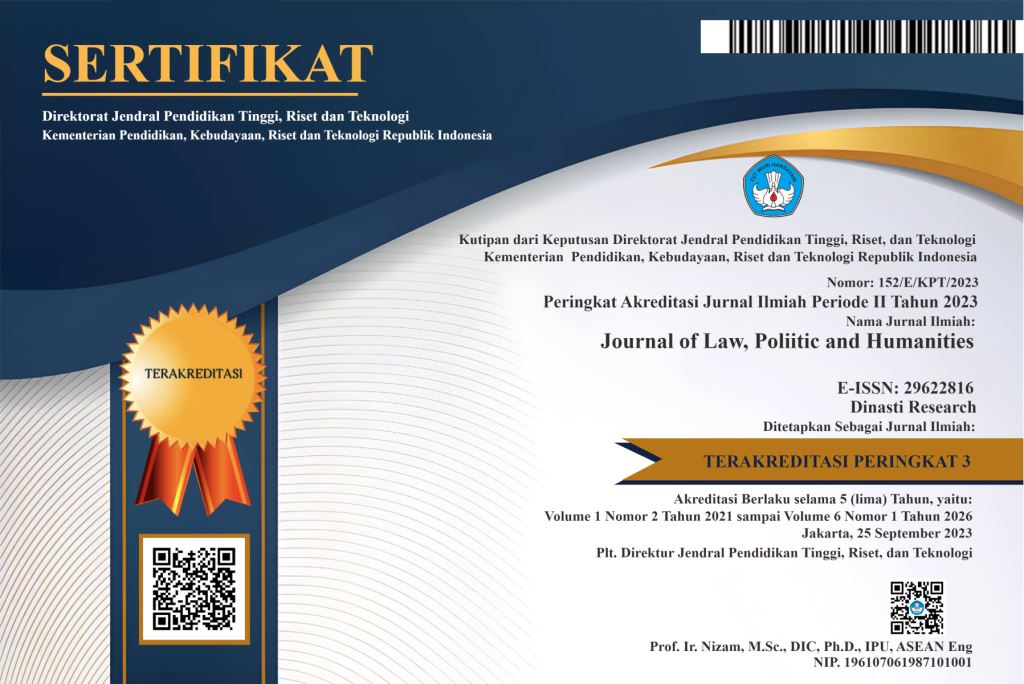Conflict Escalation in Myanmar After Military Junta Coup
DOI:
https://doi.org/10.38035/jlph.v5i4.1562Keywords:
Myanmar, Military Coup, Conflict, Military Junta, ASEANAbstract
This research aims to analyze the escalation of conflict in Myanmar after the military coup in 2021 with a research focus on understanding the dynamics of conflict during military junta rule and its impact on domestic and regional situations. This research uses a qualitative method with a descriptive-analytical approach, relying on secondary data sources, namely literature studies from various sources. The results show that the coup carried out by the military junta has overthrown the legitimate government. Instead of creating stability, this attitude triggered massive rejection by the people of Myanmar. This condition was responded aggressively by the junta, thus increasing tension and violence in various regions. ASEAN has attempted to mediate the conflict through the Five-Point Consensus, but it did not produce significant results because the military junta did not show commitment in implementing the agreement. Opposition groups such as the National Unity Government (NUG) and People's Defense Force (PDF) that were previously not major actors in the armed conflict are now increasingly active against the junta, joining forces with armed ethnic groups to overthrow the military government. This resistance has weakened the junta's control over Myanmar, indicating the potential for a greater transition of power in the future.
References
Ahmad, Daniel. (2022). ASEAN Diduga Berkolusi dengan Junta, Langgengkan Kekejaman di Myanmar. Tempo. Retrieved from https://dunia.tempo.co/read/1590705/asean-diduga-berkolusi-dengan-junta-langgengkan-kekejaman-di-myanmar.
Aldila, Nindya. (2022). Ini Lima Butir Konsensus Pertemuan Pemimpin Asean soal Myanmar. Bisnis.com. Retrieved from https://kabar24.bisnis.com/read/20210425/19/1385887/ini-lima-butir-konsensus-pertemuan-pemimpin-asean-soal-myanmar.
ASEAN Convention on Counter-Terrorism . (n.d.).
Byrd, M. W. (2024, Agustus 26). Analisis Mengatakan Militer Myanmar Berada diambang Kejatuhan Kekuasaan. Diambil kembali dari https://ipdefenseforum.com/id/2024/08/analis-mengatakan-militer-myanmar-berada-di-ambang-kejatuhan-kekuasaan/
Doherty, Ben. (2021). Myanmar military a 'terrorist group' that should face international court, advisory council says. The Guardian. Retrieved from https://www.theguardian.com/world/2021/mar/30/myanmar-military-a-terrorist-group-that-should-face-international-court-advisory-council-says.
Fajri, D. A. (2022, November 8). Justice for Myanmar Menuduh ASEAN dan Junta Militer Bersekongkol. Diambil kembali dari https://www.tempo.co/internasional/justice-for-myanmar-menuduh-asean-dan-junta-militer-bersekongkol-260085
Forum, I.-P. D. (2021). Penumpasan Perjuangan Demokrasi di Myanmar. Hak Asasi Manusia dan Kebebasan Volume 46, Terbitan ke-4.
Garyland, Carys. (2021). Global condemnation of Myanmar military's 'reign of terror' after deadliest day since coup. France24. Retrieved from https://www.france24.com/en/asia-pacific/20210328-global-condemnation-of-myanmar-military-s-reign-of-terror-after-deadliest-day-since-coup.
Hidayat, Achmad. (2021). Junta Militer Myanmar Sebut 'Kabinet Tandingan' Sebagai Teroris. Idntimes. Retrieved from https://www.idntimes.com/news/world/achmad-hidayat-alsair/junta-militer-myanmar-sebut-kabinet-tandingan-sebagai-teroris-c1c2/3.
Lipes, Joshua. (2022). More than 200 arrested for social media posts supporting Myanmar opposition. RFA. Retrieved from https://www.rfa.org/english/news/myanmar/arrests-05052022190145.html.
Mardhana, E. F. (2023, Juni 14). 6.000 Warga Sipil Myanmar Tewas dalam 20 Bulan Pascakudeta. Diambil kembali dari https://international.sindonews.com/read/1126631/40/6000-warga-sipil-myanmar-tewas-dalam-20-bulan-pascakudeta-1686733573
Padmi, M. F. (2024). Diplomasi Parlemen Memulihkan Myanmar Menjaga ASEAN. Jakarta: Sekretarian Jenderal DPR RI.
Prihastomo. (2022). Interpol Tolak Permintaan Militer Myanmar untuk Bantu Memerangi Terorisme. Kontan. Retrieved from https://internasional.kontan.co.id/news/interpol-tolak-permintaan-bantuan-militer-myanmar-untuk-memerangi-terorisme.
Putsanra, D. V. (2021, Februari 4). Apa yang Terjadi di Myanmar Sekarang dan Penyebab Kudeta Militer. Diambil kembali dari https://tirto.id/apa-yang-terjadi-di-myanmar-sekarang-dan-penyebab-kudeta-militer-f9SF
Ray, Siladitya. (2021). Myanmar Security Forces Have Killed More Than 500 People Since February Coup. Forbes Africa. Retrieved from forbesafrica.com/current-affairs/2021/03/30/myanmar-security-forces-have-killed-more-than-500-people-since-february-coup/.
Rizky, Fahreza. (2022). Jokowi Sayangkan Sikap Junta Militer Myanmar Tak Laksanakan Konsensus ASEAN. Retrieved from https://nasional.sindonews.com/read/664769/12/jokowi-sayangkan-sikap-junta-militer-myanmar-tak-laksanakan-konsensus-asean-1642903285.
Sari, A. S. (2017). Membangun Keamanan Regional di ASEAN dalam Menanggulangi Ancaman Terorisme. Jurnal Wacana Politik, Vol. 2, No. 1, Maret, 22-32.
Sinaga, Y. A. (2021, Mei 9). Junta Myanmar Melabeli Pemerintah Persatuan Nasional sebagai Teroris. Diambil kembali dari https://www.antaranews.com/berita/2146726/junta-myanmar-melabeli-pemerintah-persatuan-nasional-sebagai-teroris
Sommerville, Q. (2024, Juni 17). Myanmar Memberontak Terhadap Junta Militer dan Berhasil Mengubah Arah Perang. Diambil kembali dari https://www.bbc.com/indonesia/articles/cjrrv2pzd8po
Ying-ying, Chiang. (2021). Myanmar military designates shadow gov’t as ‘terrorist’ group. Aljazeera. Retrieved from aljazeera.com/news/2021/5/8/myanmar-military-designates-shadow-govt-as-terrorist-group.
Yuliana Anggun Pertiwi, d. (2024). Insurgency in Pakistan and the Government’s Strategic Policies in Dealing with it. International Journal of Integrative Sciences (IJIS) Vol. 3 No. 11 , 1211-1228.
Downloads
Published
How to Cite
Issue
Section
License
Copyright (c) 2025 Yuliana Anggun Pertiwi

This work is licensed under a Creative Commons Attribution 4.0 International License.
Authors who publish their manuscripts in this journal agree to the following conditions:
- The copyright on each article belongs to the author(s).
- The author acknowledges that the Journal of Law, Poliitic and Humanities (JLPH) has the right to be the first to publish with a Creative Commons Attribution 4.0 International license (Attribution 4.0 International (CC BY 4.0).
- Authors can submit articles separately, arrange for the non-exclusive distribution of manuscripts that have been published in this journal into other versions (e.g., sent to the author's institutional repository, publication into books, etc.), by acknowledging that the manuscript has been published for the first time in the Journal of Law, Poliitic and Humanities (JLPH).


























